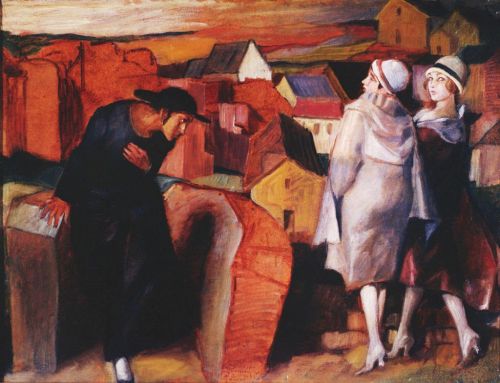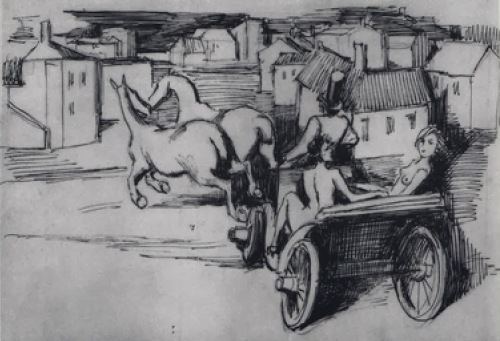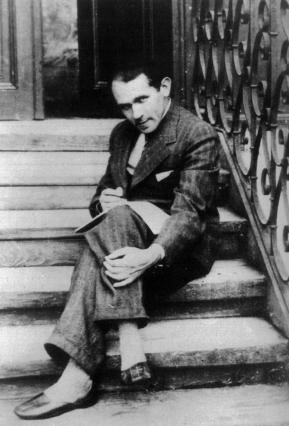
Bruno Schulz created a literary vision which defies description. His two collections of stories – “Cinnamon Shops” (1934; published in English as “The Street of Crocodiles”) and “The Sanatorium under the Sign of the Hourglass” (1937) – are so enigmatic that readers are often left puzzled as to their meaning.
Schulz himself was a complex person. Born in Drohobycz in 1892 in a Polish-speaking Jewish family, he was destined to live in a place which belonged during his life to Austria-Hungary, Poland, Soviet Union and Generalgouvernement and now is situated in Ukraine. Schulz spent his whole life in Drohobycz, only occasionally leaving his home town. Polish was his native language but he also spoke German and was exposed to Yiddish and Ukrainian. Short in statue, slightly stooped, shy and unassuming in public, Schulz never married. In his drawings, he portrayed himself as a masochist. He earned his living as a teacher of arts and crafts in a gymnasium.
Schulz’s uneventful life in a provincial town contrasts with his literary vision which is full of boundless energy.
Schulz explains that his aim is the mythicisation of reality and the return, or rather maturing towards childhood – “that would be genuine maturity”. He wants to have a direct and sensual contact with matter. Reality in his stories is unmediated by reason. This is Being in its totality, ens before being turned into episteme. People in Schulz’s stories are drunk on existence. Matter is ever changing and there are no constraints to its powers to transmogrify itself. Schulz writes in Spring:
It is then that the revelation took place: the vision of the fiery beauty of the world suddenly appeared, the secret message of good tidings, the special announcement of the limitless possibilities of being. Bright, fierce, and breathtaking horizons opened wide, the world trembled and shook in its joints, leaning dangerously, threatening to break out from its rules and habits. ..What a dazzling relativism, what a Copernican deed, what flux of all categories and concepts! Oh God, so there were uncounted varieties of existence, so your world was indeed vast and infinite! This was more than I had ever imagined in my boldest of dreams . . . that the world was immeasurable in its variety!

Schulz is an anarchist and he was not alone in Polish literature of his times. It is rather surprising that the interbellum Poland produced modernist writers who ventured further than writers in other European countries. Schulz, Stanislaw Ignacy Witkiewicz (Witkacy) and Witold Gombrowicz were ahead of their times and their genius gained proper recognition only in the 1960s. In order to understand Schulz, one must also read Gombrowicz’s Ferdydurke and Witkacy’s plays.
Schulz detects a change in European civilisation which was only recognised as such by the general public several decades later. Since the 1930s, science has abandoned claims to certainty. Karl Popper wrote about falsification rather than verification of claims about the external world. All scientific statements are therefore of provisional nature. Paul Feyerabend went even further by rejecting rationality and writing about totalitarianism of science.
Pantha rei – says Schulz and Feyerabend would agree. For Schulz, myths have sense-making qualities. Feyerabend says that science is much closer to myth than a scientific philosophy is willing to admit.
The Schulzian world recognises no logical, temporal or spatial constraints. And so does modern science – at least when we think about causality, space and time in Kantian way, as mental categories imposed on the external world. The world is indeed getting weirder and weirder, not only in literature but also in reality – whatever this term denotes and connotes.
It seems that God is a poet, not a watchmaker.
Schulz was shot in the head by an SS-man in the Drohobycz ghetto on 19 November 1942.

What still remained of him-the small shroud of his body and the handful of nonsensical oddities-would finally disappear one day, as unremarked as the grey heap of rubbish swept into a corner, waiting to be taken by Adela to the rubbish dump (Visitation).

His artwork was fantastic. Do you know if he displayed is drawings/paintings in public prior to the war, and if he did, how they were received? His portrayals (masochist) were quite bold and psychologically nuanced for the time (I think, anyway). I think he’s deserving of far more renown both as an artist and writer.
LikeLike
His drawings were indeed shown at exhibitions in Warsaw and Lwow (both in 1922) and in Vilnius, Lwow and Cracow in later years. I couldn’t find information about the reception of his art at that time but it was a period of experimenting in Polish literature and art so the public wouldn’t necessarily be shocked. Schulz’s friend Witkacy painted under the influence of drugs. For more information about Schulz, I recommend Jerzy Ficowski’s Regions of the Great Heresy. Wojciech Has adapted Schulz’s stories to cinema, quite successfully, I think. The film is here https://www.youtube.com/watch?v=OI7siwd35jw
Greetings
LikeLike